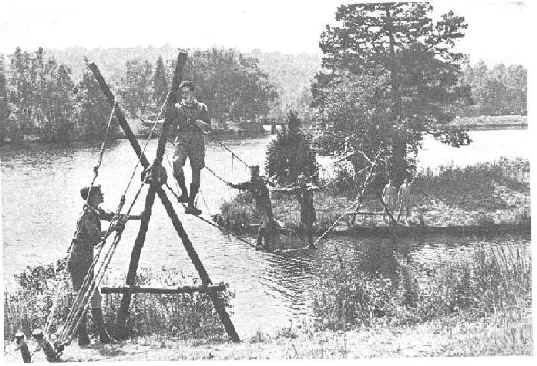

Monkey Bridge Construction
By William Hillcourt
Reprinted from Boy's Life
The construction of a Monkey Bridge is a pioneering feat that will thrill your gang. The monkey-type of bridge has the advantage over the usual pioneering bridge that it can he used to span a much greater distance--up to one hundred feet.
Baden-Powell brought the idea from India. There he had seen the natives in the Himalayan mountains make "bridges out of three ropes . . . connected together so that one rope: forms the footpath and the others make the handrail on each side."
It wouldn't be much fun to cross this kind of swaying bridge over a deep mountain chasm, but it's fun in camp where the worst you could get out of a slip would be a ducking.
Three long manila ropes are required. The foot rope should he one inch in diameter, the hand ropes one-half inch. The ropes should be about thirty feet longer than the width of the river to provide enough length for anchoring. The stringers are made of one-quarter inch rope. As they are placed three feet apart, you will get the number of them by dividing the length of the bridge span by three. In Addition, you will need quarter-inch rope for lashings.
The wood part of the construction consists of four logs for shear legs, twelve feet long, four inches thick, and two cross pieces, three inches thick, four to five feet long.
To do an effective job, divide the gang into two teams--one team to make the shear legs, the other to lay out the ropes ad attach the stringers. When these two jobs are done, the whole gang works together on the erection of the bridge.
A Patrol can build a Monkey Bridge during an afternoon in camp or on a whole-day hike--and that's real pioneering.
Figures and Explanations
 The Shears
The Shears
 The Ropes
The Ropes
 Determine the length of the main ropes.
Determine the length of the main ropes.
 Lay out the Ropes.
Lay out the Ropes.
 Attach the Stringers.
Attach the Stringers.
 Lay out the Shears.
Lay out the Shears.
 Lash the Shears.
Lash the Shears.
 Drive shear anchors.
Drive shear anchors.
 Install ropes and shears.
Install ropes and shears.
 Install shear pad.
Install shear pad.
 Attach Foot ropes.
Attach Foot ropes.
 Attach Hand ropes.
Attach Hand ropes.
 Give ropes final tightening.
Give ropes final tightening.
 THE FINAL PRODUCT
THE FINAL PRODUCT